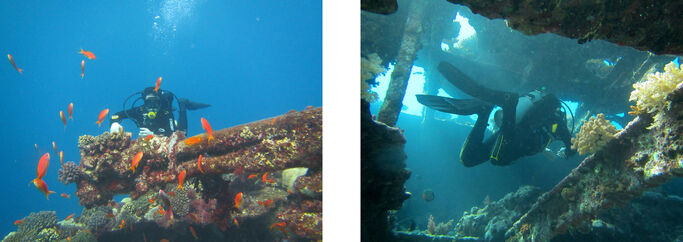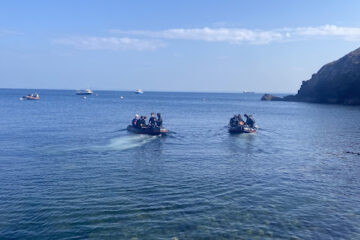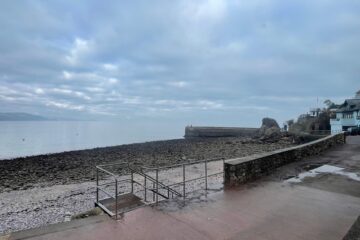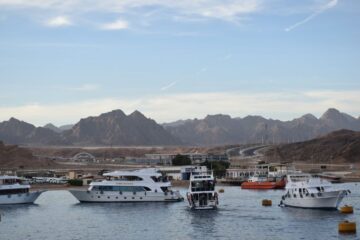Day 1 – Poseidon Reef (Check Dive) – by Chris Bainbridge
Our boat was moored off the east side of Poseidon Reef, also known as Sha’ab El Erg. The reef itself is located just north of Hurghada, and looks somewhat like a horseshoe. It’s a very shallow reef, reaching a max depth of around 15 metres, and currents tend to be mild. When we were there, the temperature was a balmy 21 degrees.
The first dive of the trip is always to check weights, as after the first dive there isn’t really time to do re-adjustments. We spent quite a lot of time swimming back and forth between the line and the boat, mainly because I underestimated the amount of weight I required. Unfortunately in the large swells Carla dropped her GoPro, but thankfully after a bit of searching we managed to find it again.
Keeping the reef to our right shoulder, we headed south. The bottom of the reef is quite rocky to begin with, although it gets sandy as you turn the corner and start heading west. Vis was about 15 metres. There were a few other divers on the reef as well as us, but it didn’t seem crowded at all. We saw plenty of fish, both large and small. We had a very large masked pufferfish swim right by us, spent some time trying to get our teeth cleaned by the cleaner wrasse and just spent the rest of the dive being mesmerised by the amount of fish swimming around us.
Fish
- Parrot Fish
- Masked Pufferfish
- Butterflyfish
- Forsskal Goatfish
- Red Sea Bannerfish
- Cleaner Wrasse
- Trigger Fish
Day 1 – Sha’ab Abu Nuhas Reef – by Chris Bainbridge
Famous for its wrecks, the reef Sha’ab Abu Nuhas is also ideal to dive, as it’s again relatively shallow. We only managed a maximum depth of 12.6 metres, but that allowed us to have a 56 minute dive.
We went in at 17:02, just as the sun was setting. It got darker as we swam along the reef, so torches were a must! It was my first night dive, so I’ll admit I was a little nervous. Thankfully the gradual dimming allowed us to get our bearings, so we managed to find our way back easily.
We spent a lot of time wandering slowly along the reef, looking in holes at the sleeping fish, and saw our first lion fish of the trip. Probably the best part of the dive was seeing a large moray eel swimming slowly along the sea bed. As morays are only active for about 2 hours a day, we were very lucky!
On the way back to the boat, we were surrounded by lots of shoals of small fish. I was also enthralled by the sight of the torches of our other divers shining through the water, it was a very beautiful sight.
Fish
- Moray Eel
- Lion fish
- Trigger Fish
- Scorpion Fish
- Parrot Fish
Egypt Trip Report: Day 2 – David Wise
Our second day of diving began at the slightly jarring hour of 5.30, although the experience was softened by the crew’s generous offer to bring everyone a hot drink along with the wakeup call. Having left bed at varying rates of knots, everyone made their way to the main cabin to do their tank check and to get ready for the dive brief at 6 o’clock.
The boat was still moored on the south side of the reef of Sha’ab Abu Nuhas where we had dived the previous day. Over the years, the reef had proved to be a significant obstacle for ships leaving the Gulf of Suez, with the wrecks of five to be found on its north side. The plan was to dive two of these that morning, with the first being the Chrisoula K, the ‘Wreck of the Tiles’. The Chrisoula K was a Greek cargo vessel, nearly 100m long, which had run aground on the reef in 1981 whilst on route to Jeddah and subsequently sunk beneath the surface. So that the crew could make our breakfast in time for our return from the dive, we would take the Zodiac ribs to and from the wreck.
With the brief complete and new buddy pairings sorted – a practice that would confuse the dive guides for the rest of the week – everyone kitted up and piled into the Zodiacs for the short trip to the other side of the reef. Although short, the high winds made for some rough seas and it was with relief that we reached the site of the wreck and rolled off the boats. Having been deposited over the centre of the fairly intact ship, we descended down its starboard side to look at the eel garden (lots of sand eels poking their heads out of the sand) found on the sea bed there. We could then swim around to the stern to look at the propeller before heading inside the ship to explore its holds and its various cargos of tiles and construction equipment. On reaching the bow, some divers encountered a giant moray swimming in open water, exciting but ever so slightly unnerving. After more exploring and an excellent wreck dive, we returned to the surface and took the Zodiacs back to the boat.
After a quick breakfast Red Sea Adventurer motored around to the other side of the reef to prepare for our second wreck dive of the morning: the SS Carnatic. The ship had run aground on the reef in 1869, very close to where the Chrisoula K would later meet her end, and the wreck now lay on her port side at a depth of between 17 and 28m. After our briefing we headed into the water to explore what is undoubtedly the most beautiful dive site I have encountered. Despite its great age, the wreck is still in fantastic condition, although the ship split upon sinking, the stern and bow lie close together and aligned, so that the wreck appears intact. Though the original deck is gone, the beams that once supported it remain and their rich clothing of coral creates an environment that feels almost ethereal. Near it on the sand, half sunk, lie the ships masts. Stretching away and down to the deepest point of the wreck, exploring to their ends allowed a wonderful return view of the whole wreck.
With the dive on the Carnatic complete we returned to the boat, lunched and prepared for what was predicted to be a ‘rough’ crossing of the Gulf of Suez in order to reach the wreck of the SS Thistlegorm, where we would do an afternoon and night dive that day. The crossing was as predicted and standing still on the top deck of the boat for more than five seconds was a serious achievement, but with our destination reached we prepared to dive what is probably the Red Sea’s most famous site.
The Thistlegorm was a 128m British Merchant Navy vessel, sunk in 1941 by German bombers, the wreck now lies in 30m of water. The plan during our first dive was to descend a shot line to the vessel’s stern and from there to explore the outside of the ship, leaving its holds and their contents for the next morning’s dive. The dive guides also mentioned that we might, if we were lucky, spot a turtle that had made the Thistlegorm its home during the nights. Entering the water and descending to the wreck, it quickly became apparent that this was a very different wreck dive to the two we had done earlier that day: the sheer size of the ship and the considerably murkier water lent a somewhat eerier feel to the experience. Starting at the stern, we got a chance to look at the Thistlegorm’s two huge anti-aircraft guns. The stern is slightly separated from the remainder of the ship by the remains of the Thistlegorm’s fourth and final hold – the area that was struck by bombs – and passing over this void gave us a view into the internals of the vessel and what we would be exploring the following morning. As we headed towards the centre of the ship and the bridge there were huge shoals of fish surrounding the wreck, with some very large batfish interspersed among them. Some divers spotted tuna and barracuda on the outskirts of these groups. Swimming past the bridge and towards the bow took us over the second and first holds and past the wrecks of the railway cars that had been on the deck outside them. Upon reaching the bow and turning, some of us were lucky enough to spot the turtle heading into hold one for the night. After completing the dive we ascended a shot line at the bridge, looking forward to the opportunity of two further dives with which we could explore more of the ship.
We were all called together for the briefing before our night dive at about 6.30, but were told that unfortunately the current was too strong for a night dive to be safe. There was obviously a certain initial disappointment but closer inspection of the sea, and the discovery that it was doing a passable impression of the Zambezi at the Victoria falls, led most to the conclusion that an evening in wouldn’t be so bad after all. The discovery of Frozen in the boat’s movie collection lifted spirits further and all went to bed in sanguine mood, ready for another day’s diving.
Egypt Trip Report: Day 3 – Alex Bourla
It was another early start for our second dive on the Thislegorm. Having explored the stern, deck & superstructure the previous day (and with a mighty current running along the wreck!) the plan for this dive was to thoroughly explore the holds and bridge/accommodation area.
David Wise and I were lucky enough to be one of the first pairs on the wreck and we decided to start our dive at hold 4 – the empty hold, except today it wasn’t so empty after all with a resident turtle chilling out in the hold! We spent some time with the turtle (who it must be said didn’t seem to appreciate our company as much as we appreciated its). After a few minutes (and no doubt aware of the swarms of divers soon to occupy the wreck) the turtle took its cue to gracefully swim off and we carried on with our dive.
Slowly working our way back through holds 3, 2 and 1 we admired all the amazingly preserved cargo including trucks, jeeps, motorbikes, guns, airplane parts, train carts and more. We turned around at the bow and made a (rather currenty!) dash over the deck back to the superstructure. We explored the captain’s cabin (still fully equipped with bath & toilet!) and then up to the bridge before starting our ascent back to the surface. The fairly extreme current made of a rather interesting ascent literally hanging onto the shot line for dear life! At the surface we (well Jack…) spotted a couple more turtles which was a fitting end to a really amazing dive :D.
Our second dive of the day was on the Kingston – a rather old medium-sized steam ship that ran into Shag Rock in 1881. The wreck has now been almost fully taken over by coral growth to the point where it’s hard to really distinguish between the bow of the wreck and the reef. That said, for its age, the wreck is still rather intact. All this made for a really extremely pretty & atmospheric wreck dive. Anya and I did a couple of loops of the wreck admiring the prop, rudder, mast & boilers as well as swimming through the inside of the wreck between the beams that once supported the decks. One interesting feature of the wreck was some tiller mechanism still in-place at the back of the wreck – here Anya and I attempted a leaning-tower-of-pisa-esque photo of me driving the ship (see below), I’m not sure we were too successful but I’ll leave that for you to judge!

Worth pointing out that there were loads of fish on the wreck. In fact there were so many fish that one of them decided to photo bomb Chris…
Our last two dives were based on the barge located at Gubal Island. The barge itself is almost totally broken up with only some bits of the sides of the barge still left. That said, the barge itself and the area around it are home to loads of coral and life. On our third dive Anya and I initially stayed near to the wreck and saw lots including lionfish, stone fish, barracuda, some big wrasse thing (technical term…) and a couple of small grey eels. We then went away from the wreck where we started seeing numerous moray eels of varying sizes, some fairly impressively large clams, inadvertently pissed off some anemone fish and saw more grey eels. Having swam fairly far from the wreck we took a slightly lucky guess on the correct direction back and eventually found our way back to the wreck. We did one more circuit of the barge, seeing yet more eels and then back to the boat.
We finished our days diving with a night dive of the barge. This time I dived with David Wise and again on this dive we saw lots of eels, lionfish, shrimp, sleeping parrotfish and more. This brought a really amazing day’s diving to an end. The dives on the Thislegorm and Kingston in particular were some of my favourite dives of the holiday (and probably some of my favourite dives ever in fact!) and I’ll remember them for quite a long time to come :).



0 Comments